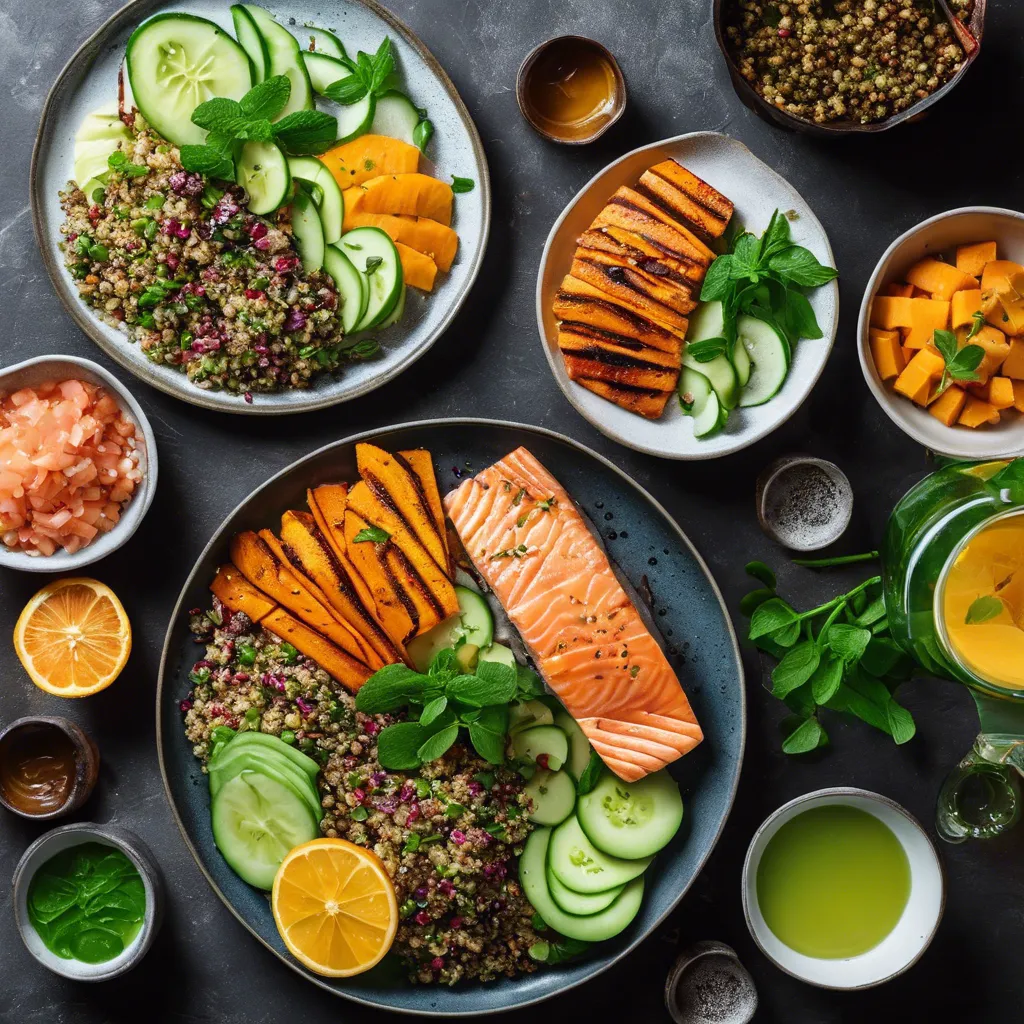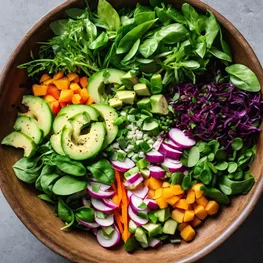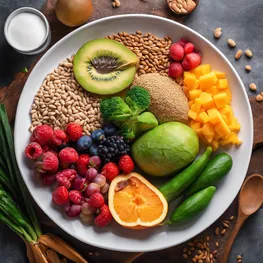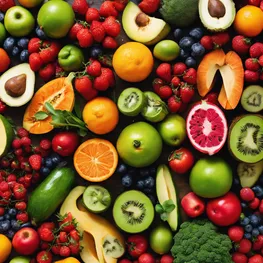Table of contents
- Understanding the Low-Glycemic Index
- Unveiling the Secrets of Sensational Low-Glycemic Cooking
- Energize Your Day with Breakfast Delights: Low-Glycemic Recipes
- Lunch and Dinner Feasts: Savory Low-Glycemic Recipes
- Discover the Sinfully Delicious World of Low-Glycemic Decadent Desserts
If you're looking to take your culinary skills to the next level, we have just the thing for you. Our sensational low-glycemic recipes will not only elevate your cooking game, but also promote a healthy lifestyle. From flavorful main courses to delectable desserts, discover a whole new world of delicious dishes that won't spike your blood sugar. Get ready to impress your friends and family with these nutritious and mouthwatering creations.
Understanding the Low-Glycemic Index
The glycemic index (GI) is a measurement used to rank carbohydrates based on how quickly they raise blood sugar levels. Understanding the glycemic index can be helpful in managing blood sugar levels effectively.
-
What is the glycemic index?
The glycemic index is a scale that assigns a numerical value to carbohydrate-containing foods based on their impact on blood sugar levels. Foods with a high GI value (70 or above) are rapidly digested and cause a sharp increase in blood sugar levels, while foods with a low GI value (55 or below) are digested more slowly, resulting in a gradual rise in blood sugar levels.
-
Why is the glycemic index important for blood sugar management?
Managing blood sugar levels is crucial for individuals with diabetes or those looking to prevent the development of the condition. By consuming foods with a low glycemic index, the spikes in blood sugar levels can be minimized, leading to better blood sugar control. This is especially beneficial for individuals with diabetes who need to carefully monitor and manage their blood sugar levels throughout the day.
-
Factors affecting the glycemic index
Several factors can influence the glycemic index of a food, including the type of carbohydrate, the food's preparation method, and the presence of other macronutrients such as fat and protein. Generally, foods that are high in fiber or have a higher fat or protein content tend to have a lower glycemic index as they slow down the digestion and absorption of carbohydrates.
-
Benefits of consuming low-glycemic index foods
Consuming foods with a low glycemic index has several benefits. Firstly, they provide a more sustained release of energy, keeping us feeling fuller for longer and preventing sudden hunger cravings. Secondly, they help maintain stable blood sugar levels, reducing the risk of developing insulin resistance and diabetes. Furthermore, low-glycemic index foods can assist in weight management as they are typically lower in calories and promote better control over food intake.
-
Examples of low and high glycemic index foods
Some examples of low-glycemic index foods include non-starchy vegetables, whole grains, legumes, and most fruits. On the other hand, high-glycemic index foods include white bread, white rice, sugary beverages, and processed snacks. By incorporating more low-glycemic index foods into one's diet, individuals can make healthier food choices and maintain better blood sugar control.
Unveiling the Secrets of Sensational Low-Glycemic Cooking
Incorporating complex carbohydrates and fiber is important for low-glycemic cooking. These nutrients provide sustained energy, promote digestive health, and help control blood sugar levels.
Energize Your Day with Breakfast Delights: Low-Glycemic Recipes
Start your day off right with a nutritious and delicious breakfast that won't cause a spike in your blood sugar levels. Low-glycemic breakfast options are not only healthy but also satisfying, providing you with the energy you need to tackle the day ahead. Here are some breakfast delights that are both low-glycemic and mouthwatering:
-
1. Veggie Omelette
Packed with fiber-rich vegetables like spinach, bell peppers, and mushrooms, a veggie omelette is a perfect low-glycemic breakfast choice. Eggs provide a good source of protein, keeping you fuller for longer, while the vegetables add essential vitamins and minerals.
-
2. Greek Yogurt Parfait
Greek yogurt is low in sugar and high in protein, making it an ideal base for a low-glycemic breakfast. Layer it with fresh berries, nuts, and a drizzle of honey for some natural sweetness. This parfait not only tastes delicious but also provides probiotics and antioxidants to support your gut health.
-
3. Chia Seed Pudding
Chia seeds are packed with fiber, omega-3 fatty acids, and antioxidants. Mix them with your choice of milk and a touch of sweetener, such as stevia or maple syrup, and let it sit overnight. In the morning, you'll have a creamy and indulgent low-glycemic pudding that will keep you satisfied all morning.
-
4. Whole Grain Toast with Avocado
Swap your regular white bread for whole grain toast topped with mashed avocado. Whole grains have a lower glycemic index, meaning they are digested more slowly and provide sustained energy. Avocado adds healthy fats that keep you feeling full and provides a creamy, rich taste to your breakfast.
-
5. Quinoa Breakfast Bowl
Cooked quinoa is a great alternative to oatmeal for a low-glycemic breakfast. Top it with fresh fruits, nuts, and a sprinkle of cinnamon for added flavor. Quinoa is a complete protein and contains essential amino acids, making it a nutritious option to start your day.
Lunch and Dinner Feasts: Savory Low-Glycemic Recipes
When it comes to satisfying and nutrient-rich low-glycemic lunch and dinner ideas, there are plenty of delicious options to choose from. Incorporating lean proteins like grilled chicken or fish, along with plenty of colorful vegetables, can help keep blood sugar levels stable and provide a wide array of vitamins and minerals. Whole grains like quinoa or brown rice can be included as a source of fiber and additional nutrients. Additionally, incorporating healthy fats from sources like avocado or olive oil can add depth of flavor and keep you feeling satisfied. Overall, with a little creativity, it's easy to create low-glycemic feasts that are both delicious and good for you.
Discover the Sinfully Delicious World of Low-Glycemic Decadent Desserts
Managing blood sugar levels can be challenging, but with low-glycemic desserts, you can indulge your sweet tooth without compromising your health. Discover a sinfully delicious world of decadent desserts that won't cause a spike in your blood sugar and allow you to enjoy guilt-free treats.
In conclusion, these sensational low-glycemic recipes are a game-changer for those looking to elevate their culinary skills. By incorporating ingredients with a lower impact on blood sugar levels, these recipes offer both health benefits and exquisite flavors. Whether you're a seasoned chef or a beginner in the kitchen, exploring these recipes will not only broaden your culinary repertoire but also enhance your understanding of how to create delicious meals without compromising on nutrition. So why not embrace the challenge of mastering low-glycemic cooking and delight your taste buds while nourishing your body?
Frequently asked questions related to sensational low glycemic recipes
What does it mean for a recipe to be low-glycemic?
A low-glycemic recipe refers to a dish that contains ingredients with a low glycemic index. This means that the carbohydrates in these ingredients are digested and absorbed slowly, resulting in a gradual rise in blood sugar levels.
Can low-glycemic recipes still be delicious?
Absolutely! Low-glycemic recipes can be both healthy and delicious. By using flavorful herbs and spices, incorporating lean proteins, and experimenting with different cooking techniques, you can create low-glycemic dishes that are full of taste and satisfy your cravings.
Are low-glycemic recipes only suitable for people with diabetes?
While low-glycemic recipes can be particularly beneficial for people with diabetes as they help regulate blood sugar levels, they are not exclusively for them. Anyone can benefit from incorporating low-glycemic recipes into their diet, as they promote overall health and well-being.
What are some examples of low-glycemic ingredients?
Some examples of low-glycemic ingredients include whole grains (such as quinoa and barley), legumes (such as lentils and chickpeas), non-starchy vegetables (such as broccoli and spinach), and healthy fats (such as avocado and olive oil). These ingredients are known for their slow-digesting properties and are great for creating balanced and nutritious meals.
Why should I cook low-glycemic recipes?
Cooking low-glycemic recipes can have several benefits. They can help stabilize blood sugar levels, promote weight loss, and reduce the risk of chronic diseases such as diabetes and heart disease. Additionally, low-glycemic recipes often include nutrient-rich ingredients that provide essential vitamins and minerals.
Are there any cooking tips for preparing low-glycemic recipes?
When preparing low-glycemic recipes, it's important to choose whole foods over processed ones. Opt for fresh ingredients, minimize the use of added sugars, and focus on cooking methods that preserve the natural flavors and textures of the ingredients. Additionally, don't be afraid to get creative with herbs, spices, and healthy fats to enhance the taste of your dishes.







